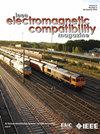具有衬垫接缝的外壳屏蔽效能的等效模拟方法
IF 2.5
3区 计算机科学
Q3 ENGINEERING, ELECTRICAL & ELECTRONIC
IEEE Transactions on Electromagnetic Compatibility
Pub Date : 2025-03-18
DOI:10.1109/TEMC.2025.3540518
引用次数: 0
摘要
衬垫缝是影响外壳屏蔽效果的关键因素。为了准确地模拟外壳的屏蔽效果,有必要对衬垫缝进行建模。然而,由于衬垫接缝接触面上复杂的微观结构,直接测量和建模衬垫接缝是具有挑战性的。为了解决这一问题,本文提出了一种等效的建模方法。基于传递阻抗恒定的约束,将衬垫层建模为各向同性规则结构,而不是对几何细节进行建模。通过建立关键参数(包括几何参数和材料参数)与测量的衬垫缝传递阻抗之间的联系,可以使不同建模条件下的传递阻抗相同。这确保了通过衬垫缝泄漏的电磁场保持一致,最终达到等效的屏蔽效果。通过这种方式,建模和模拟衬垫接缝变得简单和实用,同时保持计算准确。实验结果证实了等效建模方法的有效性。本文章由计算机程序翻译,如有差异,请以英文原文为准。
Equivalent Simulation Approach for the Shielding Effectiveness of Enclosures With Gasketed Seams
The gasketed seam is a critical factor affecting the shielding effectiveness of the enclosure. To accurately simulate the shielding effectiveness of the enclosure, it is necessary to model the gasketed seam. However, due to the complex microstructures on the contact surface of the gasketed seams, directly measuring and modeling the gasketed seams is challenging. To address the issue, this work puts forward an equivalent modeling approach. Based on the constraint that the transfer impedance is constant, the gasketed seams are modeled as isotropic regular structures instead of modeling the geometrical details. The transfer impedance can be made identical under different modeling conditions by establishing a connection between the key parameters (including the geometric and material-related ones) and the measured transfer impedance of the gasketed seam. This ensures that the electromagnetic field leakage through the gasketed seam remains consistent, ultimately achieving equivalent shielding effectiveness. In this way, modeling and simulating gasketed seams become straightforward and practical while keeping calculations accurate. Experimental results confirm the effectiveness of the equivalent modeling approach.
求助全文
通过发布文献求助,成功后即可免费获取论文全文。
去求助
来源期刊
CiteScore
4.80
自引率
19.00%
发文量
235
审稿时长
2.3 months
期刊介绍:
IEEE Transactions on Electromagnetic Compatibility publishes original and significant contributions related to all disciplines of electromagnetic compatibility (EMC) and relevant methods to predict, assess and prevent electromagnetic interference (EMI) and increase device/product immunity. The scope of the publication includes, but is not limited to Electromagnetic Environments; Interference Control; EMC and EMI Modeling; High Power Electromagnetics; EMC Standards, Methods of EMC Measurements; Computational Electromagnetics and Signal and Power Integrity, as applied or directly related to Electromagnetic Compatibility problems; Transmission Lines; Electrostatic Discharge and Lightning Effects; EMC in Wireless and Optical Technologies; EMC in Printed Circuit Board and System Design.

 求助内容:
求助内容: 应助结果提醒方式:
应助结果提醒方式:


